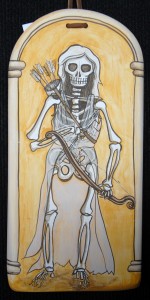The Spanish conquest of common day Mexico altered the lives of the indigenous people immensely. Not only was the land changed, their social and political systems tested and altered, their way of live and religion were violently altered. Italian anthropologist’s, Carol Severi, study of this revealed the new religion that emerged from the situation the indigenous were thrust into. Christianity was delivered to the natives and their old religion was thrown out; but when the priests who taught Christianity left generations later, the natives had to adapt to a religion that used to be taught to them, and they created a blended religion, a mix of the new and old. Interesting enough, this was expressed through their art. Dona Sebastiana was adapted, a version close enough to Saint Sebastian, but with enough differences to show the blend of old and new and creation of a new symbol. This art tells a great deal about the society.
As Severi brushed on in lecture, this relates to Aby Warburg and his study of art, mainly, his assertion that art serves more than visual pleasure. Warburg believes that art constructs the memory of a society, that art serves as a social memory as a society can choose what it what to presents to the rest of the world. This is a completely different spin on the view of art then I have ever heard of, but it is simply logical. Art is a type of expression. People want to express parts of their lives that mean a lot to them, why else would one spend hours and a countless amount of effort constructing it if it wasn’t important.
Struggles, triumphs, changes, traditions, leaders, commoners, monuments, terror, love and so many more parts of a society are expressed through art as these are the important parts of this society, the parts they want the rest of the world to know. Take Paris, a majority of the art associated with it is the Eiffel Tower. Because it represents the city and thats what its known for. Art from many societies express their leaders, as they hold much importance and influence the society greatly.
Art is a form of expression that others can’t change. Sure, there will be art where its non monumental to a society. However, much art holds that emphasis over a society. More than that, images are necessary to exercise a certain kind of thought, thoughts that the societies hold and express and share with the world through art.
References:
Picture 1:http://delgadoarts.wordpress.com/2011/08/15/dona-sebastiana-lady-sebastian/http://en.wikipedia.org/wiki/Aby_Warburg
Picture 2http://write-shoot-cut.com/2013/01/25/advert-partypoker-fr/
http://en.wikipedia.org/wiki/Aby_Warburg




